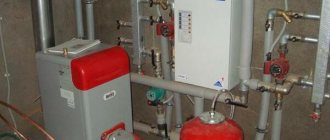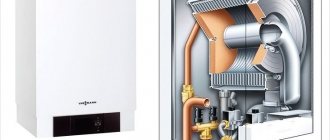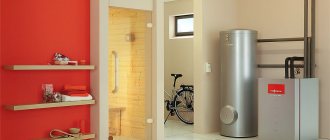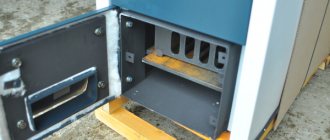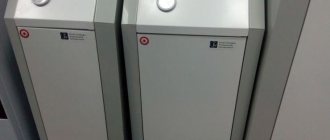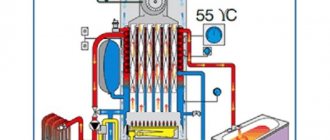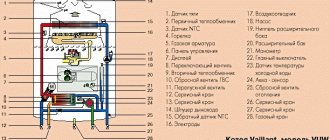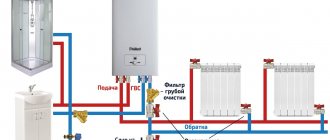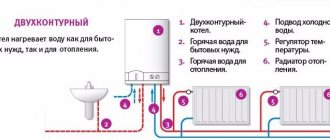A gas boiler is quite capricious and not a simple unit; it is one thing when it is non-volatile and quite another when operating from the mains.
What happens during power surges?
- The control board may burn out.
- Failure or accelerated wear of the circulation pump.
- The flame goes out or cannot be rekindled.
- The installed program is lost.
- etc.
Moreover, if the control board fails during a power surge, this is the most common failure; in this case, service centers can easily determine the cause of the malfunction and refuse to repair or replace the microcircuit with a new one; this is not a warranty case.
There are several ways to avoid major problems with the heating system, options from budget to the most expensive.
Boiler stabilizer
This is the simplest and most cost-effective option for protection against power surges. A stabilizer is purchased, most often relay (step adjustment), hung on the wall (there are floor-mounted ones) next to the boiler, the stabilizer itself is plugged into an outlet, and the boiler is plugged into an outlet on its body. All. What models are the most popular now?
Resanta LUX ASN-1000N/1-C
— relay model with a power of 1 kVA (~700 W), operating range 140 - 260 V, error 8%, there is protection against short circuit, overheating, overvoltage, and interference (Fig. 1).
Price approximately 3,000 rubles.
, example →
Bastion TEPLOCOM ST-888
- relay, power 888 VA (~620 W), operating range 145 - 260 V, error 10% (Fig. 1), price approximately
4,700 rubles.
Rucelf BOILER-1200
- relay, power 1.2 kVA (~840 W), operating range 150 - 250 V, error 8% (Fig. 1), price approximately
4,500 rubles.
, example →
Energy ARS-1000
- relay, power 1 kVA (~700 W), operating range 140 - 260 V, error 4% (Fig. 1), price approximately
5,200 rubles.
, example →
Fig.1. The appearance of the stabilizers Resanta LUX ASN-1000N/1-C, Energy ARS-1000, Bastion TEPLOCOM ST-888 and Rucelf KOTYOL-1200 differs significantly, the filling of the devices is not so much, but also different.
Fig.1-a. Energia ARS-1000 has a special pin for correct connection of phase-dependent boilers (polarity protection).
Note
.
ExpertKotel.ru does not recommend stabilizers and UPSs with a capacity below 800 VA, especially for double-circuit boilers. When the voltage drops, the output power of the stabilizer or UPS also decreases, for example, the Resanta LUX ASN-1000N/1-Ts
will output ~350 W (~50% of the nominal) when the voltage drops to 140 volts. If the total load power is higher than what the stabilizer is currently producing, it will turn off and turn off the boiler. Therefore, it is better to take into account the reserve in case of voltage drop, the optimal power is 1 kVA, 1.5 kVA or 2 kVA. This also applies to UPS.
Stabilizer for boiler (inverter)
At the moment, this is the most advanced stabilization technology, more and more manufacturers are releasing corresponding models, we will focus on the most popular.
Shtil InStab IS1000
— inverter model with a power of 1 kVA (~ 700 W), operating range 110 - 290 V, error 2%, provides absolute protection against voltage surges and sags, electrical interference and distortion of the sine wave shape, providing electrical appliances with optimal voltage with a symmetrical sine wave (Fig. 2.).
Price approximately 10,500 rubles.
, example →
Fig.2. The appearance and contents of Shtil InStab IS1000 differ significantly from previous stabilizers (relay), the operating principle is discussed in detail here.
Video review of the work of Shtil Instab 500 with oven, kettle and boiler BAXI ECO Four 24
In the video, the author clearly demonstrates the operation of the stabilizer and describes the experience of using it with the BAXI ECO Four 24 boiler, and also gives a personal recommendation whether or not to buy this model. Note: previously the line included the Shtil Instab 500 model, as in the video, but when the model range was updated, the Instab 550 began to correspond to it.
Uninterruptible Power Supply (UPS)
UPS
provides voltage stabilization and power supply from the battery(ies) when the electricity is cut off, for example, in case of broken wires and other accidents. The most common types of UPS are line-interactive and online.
Line-interactive UPS
(Line-interactive) with a built-in stabilizer, in the presence of mains voltage (even significantly reduced), unlike an online UPS, they stabilize the voltage without using the battery, saving their resource and significantly extending the service life of the batteries.
The device is not demanding on the frequency of the supply voltage (allows a deviation of ±10% without switching to a battery) and can, unlike an online UPS, be powered by a conventional budget generator without electronic frequency control (as an option). An online UPS
(On-line) converts alternating current into direct current and then back into alternating current. With this scheme, the batteries are constantly switched on, and the load switches to power from the batteries instantly (0 ms), which is ideal for any gas boiler. And the output voltage is not affected by fluctuations in the electrical network, and is maintained with high accuracy and an ideal sinusoidal shape over a wide range.
It is worth clarifying that a thrifty attitude towards batteries on the part of linear-interactive UPSs and constant operation through the batteries of an online UPS does not mean that in the second case it will be necessary to change the batteries every year. The approximate service life of the battery in the first case is ~8-12 years, depending on the intensity of use, in the second case it is ~5-7 years.
Note 2.
Specialized batteries (
AGM batteries
) cannot be called budgetary, but there are certain reasons for this - these are maintenance-free, completely sealed batteries, unlike conventional car batteries, which emit sulfur dioxide and extremely flammable hydrogen, which are dangerous to humans, AGM batteries can be installed in indoors.
As for the characteristics, the difference with a car battery is even more significant; in contrast, AGM models are designed to operate in both cyclic and buffer modes. They charge 2-3 times faster, are able to withstand deeper discharges (up to 25-30% versus 10-15%), have low self-discharge (2..3% per month versus 1% per day), in addition to this they can withstand 3-4 times more discharge-charge cycles (an example of similar AGM batteries). By the way, AGM batteries are increasingly being installed on cars, not only by the owners, but already at the factory line. Energy UPS Pro 800
- line-interactive version with a power of 800 VA (600 W), operating range 170 - 280 V, error 5%, 12 volt battery, switching time to battery operation ≤6 ms (Fig. 3.) .
Price ~ 19,000 rub.
(plus at least one battery), example →
Fig.3. Externally, the Energy UPS Pro 800 is similar to a voltage stabilizer, but for operation it requires at least one 12 V battery.
Calm SW1000L
- online option with a power of 1 kVA (700 W), operating range 90 - 260 V, error 2%, 36 volt battery, switching time to battery operation 0 ms (Fig. 4.).
Price ~ 20,000 rub.
(+ 36 V battery), example →
Fig.4. To operate the Shtil SW1000L UPS, you need a module with batteries inside (on the right); 6 small 9 Ah batteries are already installed in this module at the factory.
Shtil has an option with built-in batteries, called Shtil SW1000SL, it is equipped with 3 9 Ah batteries installed in the case (Fig. 5.). Additionally, you can connect external batteries.
Fig.5. UPS Shtil Shtil SW1000SL is already equipped with 3 batteries of 9 Ah each, they are installed in the device housing (the total capacity of the battery allows autonomous operation of the boiler for up to 1.5 hours).
Why computer UPS/UPS are not suitable
Note 3.
Conventional (computer) UPSs are not suitable for working with gas boilers for two reasons: the capacity of their built-in batteries is most often designed for only 10-15 minutes. battery life (which is clearly not enough). And the output voltage has the form of a “modified sine wave,” which causes malfunctions in the operation of boilers and negatively affects the operation of circulation pumps in the heating system. Therefore, UPS kits consisting of an inverter and external battery(s) are used for boilers. Inverters have a pure sine wave, and external batteries can be selected of any capacity, based on the required battery life.
3.1. Ready-made kits
Fig.5.1. Racks are used to save space.
Of course, there are ready-made UPS plus battery kits on the market, they come with special racks for installation (Fig. 5.1), and they come without them. It is more convenient to choose between sets, because... there is no need to calculate the working time from the battery, everything is usually already indicated in the characteristics, this option is the simplest and most flexible in terms of selection.
Choosing a German gas boiler
If you have come to the choice of a gas boiler and realized that budget Italian models are not what you were looking for, then I would like to introduce to your attention the elite German brands Vaillant, Viessmann, Volf. There are also German brands of gas heating boilers, but unfortunately their factories are no longer located in Germany, so we will not use them in the article “choosing a German gas boiler.” We all understand that when purchasing a German gas boiler, first of all we buy quality and reliability, as well as a unique design. Using the example of the three most popular models, we will try to consider all the pros and cons of each and choose a gas wall-mounted heating boiler not just with German roots, but with German origin.
Vaillant turbo TEC pro VUW 242/3-3 Viessmann Vitopend 100 WH1D 24 turbo Wolf CGG – 1K – 24 Wolf CGG – 1K – 24
All models are wall-mounted, double-circuit, with a divided heat exchanger and a closed combustion chamber.
Let's look at the main characteristics.
| model | Vaillant turbo TEC pro VUW 242/3-3 | Viessmann Vitopend 100 WH1D 24 turbo | Wolf CGG – 1K – 24 |
| Efficiency % | 92,8 | 91 | 93 |
| Modulation gas burner, kW | 8,1 — 24 | 10,7 — 24,8 | 9,4 – 24 |
| Expansion tank volume, l. | 6 | 6 | 8 |
| Performance for hot water, l/min. | 11,4 | 11 | 12 |
| Consumption of natural gas, cubic m/h | 2,9 | 2,83 | 2,83 |
| Consumed Power, W | 145 | 128 | 120 |
| Weight boiler, kg | 36 | 36 | 42 |
Efficiency
One of the most important indicators that will influence the final figure in the gas payment. The table shows that all three gas boilers have good efficiency and the difference between Wolf and Vaillant is insignificant; 91% for Vitssmann is also good, but is already inferior to its competitors.
Gas burner modulation
It also affects gas consumption when using a gas boiler in small areas. As well as the service life, the lower the modulation, the easier it will be for the gas boiler to operate at street temperatures close to zero. Here the Vaillant boiler, thanks to modulation with 8.1 kW, receives special praise.
Expansion tank volume
It often happens that after purchasing a gas boiler, you still have to purchase various elements and upgrade your boiler. With the Wolf boiler, you won't have to do this, because... only the expansion tank is 2 liters. more.
Hot water capacity
If you don’t want your shower to turn into a contrast shower when you open the second tap (for example, in the kitchen), then I suggest choosing a gas boiler with maximum hot water flow. If you choose by performance, then the first choice would be Wolf, 12 l/min, this is a good indicator.
Natural gas consumption
The final gas consumption in a gas boiler is influenced by many parameters, burner modulation, fan speed. This parameter would not be taken into account, and the values for all are almost the same.
Power consumption
You are not buying a gas boiler for a year or five, and it is very important how much gas and electricity it will consume. When buying a German gas boiler, you may not constantly look at the electric energy meter, but you will save it with a Volf brand boiler.
Boiler weight
The heavier the boiler, the fewer metal parts were replaced with plastic, and hence reliability and durability.
Let's sum it up
| model | Vaillant turbo TEC pro VUW 242/3-3 | Viessmann Vitopend 100 WH1D 24 turbo | Wolf CGG – 1K – 24 |
| Efficiency % | 9 | 8 | 10 |
| Gas burner modulation | 10 | 8 | 9 |
| Expansion tank volume | 8 | 8 | 10 |
| Hot water capacity | 9 | 8 | 10 |
| Natural gas consumption, cubic m/h | 9 | 10 | 10 |
| Power consumption | 8 | 9 | 10 |
| Boiler weight | 9 | 9 | 10 |
| Design | 9 | 9 | 10 |
| The cost of a boiler with a coaxial chimney is RUB. | 15 470 000 | 13 860 000 | 11 830 000 |
| Bottom line | 71 | 69 | 79 |
When choosing and comparing German gas boilers, I would like to note the Vaillan boiler, which occupied a leading position in our comparative characteristics.
But I would still like to give preference to the German manufacturer of gas boilers Wolf, for its stylish design, innovative technologies and undoubted leadership among gas boilers in the price-quality category.
In addition to the boiler, I would like to protect the washing machine, refrigerator, stereo system, air conditioner, etc.
This is the most popular option for a country house.
4.1. Stabilizer for the whole house
If one phase
(220 volts), then they usually choose a single-phase voltage stabilizer with a power of 10-12 kW, for a small house 8 kW. But more and more often, houses are connected in a three-phase way (380 volts), in which case a three-phase stabilizer is needed, approximately 15 kW or three single-phase 5 kW each. ExpertKotel.ru reminds that when connecting three-phase motors (pumps, machines, etc.) to three single-phase 5-motors, you need to purchase a Network Control Unit (BCS), which will monitor possible phase imbalance (BCS example). For a conventional three-phase stabilizer, BKS is not needed.
Actually option 4.1. This is a repetition of points 1 and 2, but on the scale of the entire house and with the nuance of three-phase stabilizers.
Which technologies should you prefer?
The most budget options are relay ones, they have average performance characteristics, example Resanta ASN-10000/1-Ts - 10 kVA (Fig. 6.) and make clicks when switching relay stages, this feature should be taken into account if the stabilizer is installed nearby from the bedroom.
Fig.6. Resanta ASN-10000/1-C is suitable for a small house with a power of all appliances up to 7-8 kW (10 kVA).
Advanced level - thyristor and triac voltage stabilizers
, for example Energy Classic 12000 (12 kVA, thyristor, Fig. 7.) and Energy PREMIUM 12000 (12 kVA, triac, Fig. 7.). They are also stepped, but thyristors operate faster than relays and do not produce unpleasant clicks. They have a longer warranty (3 and 5 years, respectively, versus 1 year for relay devices) and in general these devices are more reliable.
A less expensive thyristor stabilizer is the Volt Engineering Ampere E 9-1/50, it has excellent equipment, for example, there are filters for high-frequency and impulse noise, protection against sparking contacts on the line and an electronic bypass with a cut-off relay function, which puts the model on a par with stabilizers of professional series. It has no buzzing, no clicking, and fan cooling is activated only under heavy loads, and the price starts at RUB 32,950. (for a power of 11 kW), the warranty is also at the level of the best and is 5 years.
Only inverter stabilizers are more expensive than thyristor and triac models; their characteristics are either at the same level or significantly superior to all analogues. For example, Shtil InStab IS12000 (12 kVA) regulates parameters without delay, i.e. the response time to changes in voltage in the network is 0 ms, it works silently, the range is not achievable for other types and is 90-310 volts.
Therefore, the advice is simple: if your budget allows, you should choose from these three options, all three are extremely worthy. Below (clause 4.2.) specific examples are described for inverter, triac and thyristor models.
Fig.7. Energy Classic 12000 (thyristor, right) and Energy PREMIUM 12000 (triac, left), both at 12 kVA (~10 kW), unlike the previous one (Fig. 6.): fast power switches, small error 5% and 1 .5% respectively, more protection options and an extended warranty from the factory - 3 and 5 years.
4.2. Stabilizer for the whole house and UPS for the boiler
The essence of the method is to install a stabilizer for the whole house (previous point 4.1.) for all electrical appliances and separately install a UPS for boiler autonomy (point 3.).
- Example 1. The house is connected to 220 volts (10 kW), Shtil appliances:
- — Stabilizer for all devices Shtil InStab IS12000 (12 kVA, inverter, 2 years warranty) + UPS Shtil SW1000SL (1 kVA, batteries included).
- — Budget ~81,000 rub.
- Example 2. The house is connected to 220 volts (10 kW), Energy appliances:
- — Stabilizer for all devices Energy Classic 12000 (12 kVA, thyristor, 3 year warranty) + Energy UPS Pro 800 (0.8 kVA) + battery 12-55 (capacity 55 Ah).
- — Budget ~69,700 rub.
- Example 3. The house is connected to 220 volts (10 kW), Energy appliances:
- — Stabilizer for all devices Energy Premium 12000 (12 kVA, triac, 5 year warranty) + Energy UPS Pro 800 (0.8 kVA) + battery 12-55 (capacity 55 Ah).
- — Budget ~81,900 rub.
- Example 4. House connected to 380 volts (15 kW), Energy appliances:
- — Stabilizer for all devices Energy Classic 15000-3 M (three-phase 15 kVA, thyristor, 3 year warranty) + Energy UPS Pro 800 (0.8 kVA) + battery 12-55 (capacity 55 Ah ).
- — Budget ~102,500 rub.
- Example 5. The house is connected to 380 volts (15 kW), Energy appliances:
- — Stabilizer for all devices Energy Premium 15000-3 M (three-phase 15 kVA, triac, 5 year warranty) + Energy UPS Pro 800 (0.8 kVA) + battery 12-55 (capacity 55 Ah ).
- — Budget ~137,900 rub.
- Example 6. The house is connected to 380 volts (15 kW), Energy and Shtil appliances:
- — Stabilizer for all devices Energy Classic 15000-3 M (three-phase 15 kVA, thyristor, 3 year warranty) + UPS Shtil SW1000SL (1 kVA, batteries included).
- — Budget ~95,600 rub.
- Example 7. The house is connected to 380 volts (15 kW), Energy and Shtil appliances:
- — Stabilizer for all devices Energy Premium 15000-3 M (three-phase 15 kVA, triac, 5 year warranty) + UPS Shtil SW1000L (1 kVA) + battery module Shtil BM-36-18.
- — Budget ~145,740 rub.
Comparison of Viessmann and Buderus boilers
It is known that today there are two undisputed leaders in the heating equipment market - Viessmann and Buderus. Both companies are German. Both have a number of advantages and disadvantages. Let's look at a comparison of their boiler equipment.
Viessmann heating equipment has been on the Russian market for almost 15 years. Most of them, of course, were supplied through gray dealers, however, over the past 6-8 years, order has been established in this area, and almost all supplies of equipment to Russia were carried out directly through the Viessmann representative office in Moscow. The company has established itself as a manufacturer of extremely reliable equipment for heating a country house or cottage. With all this, there was no too categorical gap in cost compared to other players in the boiler equipment market.
In 2002, an official representative office of the German company Buderus, known throughout Europe, appeared in Moscow, but it was a completely unknown brand on the Russian market. However, literally within 3-4 years of its official existence in Russia, this company managed to take a very strong position in the market of manufacturers of boiler equipment for cottages and country houses. Moreover, in such a short period of time, it managed to reach the top three in terms of sales volumes, and earn a reputation as very reliable and high-quality equipment for home heating.
At the same time, Viessmann is much more famous, it is a popular and fairly promoted brand, made in Germany, excellent quality, the cost of similar boilers from both manufacturers with the same configuration (type, power, automation) differs by an average of 15%, in favor of the promoted Viessmann. which is cheaper. It turns out that the lesser-known Buderus is also more expensive!
However, firstly, the most popular line of boilers from 20 to 140 kW (for houses with an area from 150 sq. m. to 1000 sq. m.) from both companies is made of cast iron, as a material that is much more durable and less capricious to high temperatures . The Buderus company, one of the few, casts boilers from its own cast iron at its own production facilities, and production is located in a distant German province near the LOGANO river. Viessmann boilers are cast in Italy at intermediary companies. This first significant difference is the quality of the manufacturing material.
Secondly, in a heating system, unfortunately, there are often situations when the water temperature in the return line becomes significantly lower than normal, i.e. If a leak occurs in the system, cold water is supplied to the hot sections of the heating boiler. As a result, a temperature shock occurs in the metal and the boiler section cracks and fails! Those. Viessmann boilers with a power of up to 50 kW cannot be repaired. Buderus has a so-called patented Termostream system, it works like this: when the return temperature is significantly lower than normal, it mixes with warm water, and only after that the coolant enters the boiler, thus damage and failure of the boiler section is much less probably, which, again, is an unconditional fact of the advantages of Buderus boilers, which, moreover, regardless of power, are repairable.
Thirdly, the efficiency of boilers. Boiler with a capacity of 140 kW. In the summer, when hot water is drawn, the boiler is turned on (to heat the water in the tank), the burner operating time of the Viessmann and Buderus boilers is different, respectively, and it is equal to 6 and 2 minutes. Thus, if you decide to wash your hands and the water temperature in the water heater tank drops below the set value, the boiler turns on. In the first case, 6 minutes, in the second, 2 minutes. It turns out that in one cycle the Viessmann boiler produces 14 kW versus 4.66 kW for Buderus. Then, a very important point - Buderus boilers with a power of more than 70 kW are equipped with two-stage burners, which very significantly affects fuel consumption when operating at powers above 100 kW. Thus, we divide the figure of 4.66 kW in half and we get that in one on-off cycle the Viessmann boiler burns exactly 6 times more fuel than the Buderus boiler, respectively, 14 kW and 2.33 kW, and our time is a constant increase in tariffs Isn’t this the most convincing argument when choosing a heating boiler in favor of Buderus?
This is how, using examples, we compared two leading manufacturers on the boiler equipment market, look, compare, the choice is always yours.
CONCLUSIONS
If the budget does not yet allow the installation of a UPS or comprehensive protection, as in the examples above, install at least a simple voltage stabilizer to the boiler; during power surges, it will protect the board and the pump, and in the event of a sag, it will pull the indicator to 220 volts, ensuring stable operation of the power supply itself. boiler and pump.
The optimal option requires certain funds.
In addition to the heating boiler, the house also contains other appliances: a refrigerator, a washing machine, etc. In this case, you need to install a stabilizer for the whole house and a UPS for the boiler. Do not lose your warranty Proper installation, maintenance, repair or design of boilers and industrial boiler rooms Catalog of companies →
Known faults of Visman boilers
As we mentioned earlier, there are very few cases of service calls in which a serious breakdown is recorded.
The most common malfunction is the failure of the automation (control unit). Although it is not always possible to determine the cause of the breakdown, the source is usually a significant voltage drop. It is not possible to influence this directly, since the causes of voltage drops are overloads at the transformer substation, poor electrical contact, when connecting a powerful electrical consumer to an adjacent line, etc. The only method of protection is to connect the boiler through a voltage stabilizer.
Another vulnerable element is the temperature sensor, the breakdown of which is typical for Vitopend 100-W models.
Frequent questions that are not always related to breakdowns are (click to expand):
+ The boiler does not turn on, there is no ignition
If the boiler does not turn on at all (the display does not work, does not respond to button presses), most likely the fuses have blown or the diode bridge has burned out. This happens due to a power surge. If the controls work, but the burner does not ignite or there is no spark, the first step is to clean the combustion chamber of soot, dust and other debris, and carefully clean the igniter. How to clean a gas boiler yourself: detailed instructions
+ The boiler began to whistle or hum
The whistling or hum may increase gradually over time; there may be several reasons: clogging of the heat exchanger with scale (usually after at least 4-5 years when using dirty hard coolant), wear of the turbine fan bearings, lack of water in the system. In this case, the main thing is not to confuse the original noise, characteristic of the operation of any boiler, with the changes that have appeared.
+ What is the normal operating pressure, how to lower/raise it
Viessmann boilers operate with water pressure from 0.8 to 3 bar. The optimal operating pressure in the heating circuit is 1.5-2 bar. The operating pressure is set during commissioning and then automatically maintained by the boiler. If the pressure is below operating limits, it is necessary to add water to the system and check the tightness of all components and connections of the CO. An increase in pressure indicates the presence of air in the system.
Most common error codes
+ Error F2
The burner is in a faulty state. Usually triggered by actual or potential overheating of the boiler. To fix the problem, you need to check the volume of coolant in the system, the presence of air, and make sure that the circulation pump is working. If the problem persists, the cause is poor contact or a faulty temperature limiter.
+ Error F4
The burner is in a faulty state, no flame signal. The error is not related to the burner itself, but to the sensor that detects the presence of a flame. It is worth checking its condition and cleaning it if necessary. It is also worth paying attention to the ignition electrodes, checking the gas pressure and shut-off valves.
+ Error F5
The combustion control unit is in a faulty state. The error is related to air exchange, namely, it occurs when there is difficulty in air intake or removal of combustion products. The most common cause is icing on the head of a coaxial chimney at temperatures of -15°C and below. Icing occurs due to the freezing of condensate formed from combustion products. To eliminate it, just carefully knock off the ice and think about insulating the outer part of the chimney or anti-icing structure. If the problem cannot be eliminated, it is worth looking for other causes of air exchange problems.
+ Error F59
No hot water is produced. Opening of the outlet temperature sensor or cylinder temperature sensor. It is worth checking the sensor contacts; if everything is normal, it is most likely faulty.
Errors are reset by simultaneously pressing MODE+OK until the “” (reset) indicator starts flashing. A simple reset can sometimes eliminate a sudden error and stoppage of the boiler, but even in this case it is worth being wary and thinking about the reasons for its occurrence.

